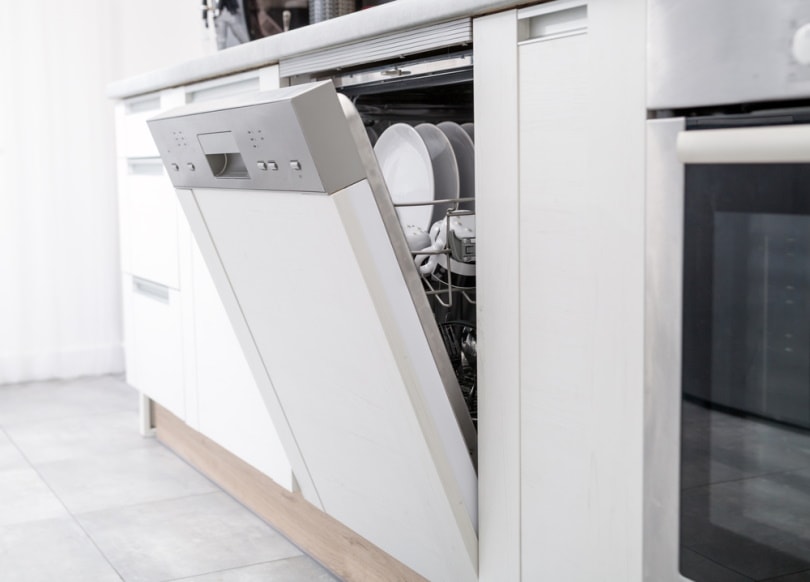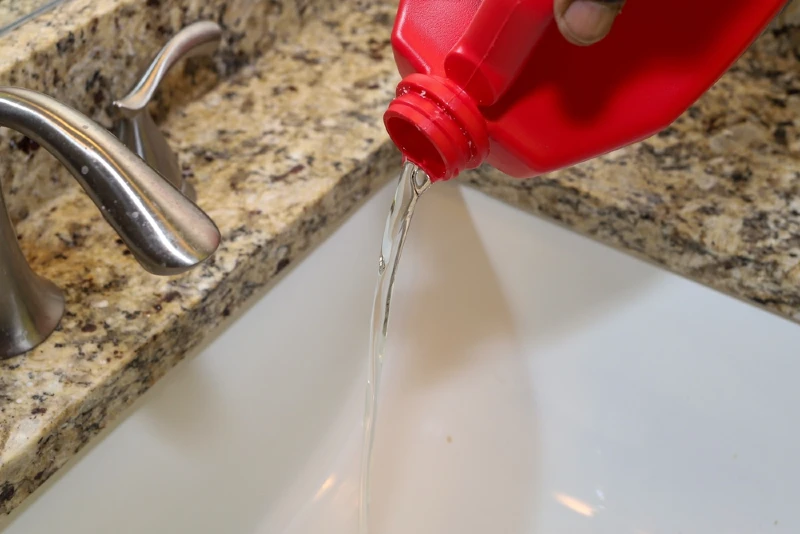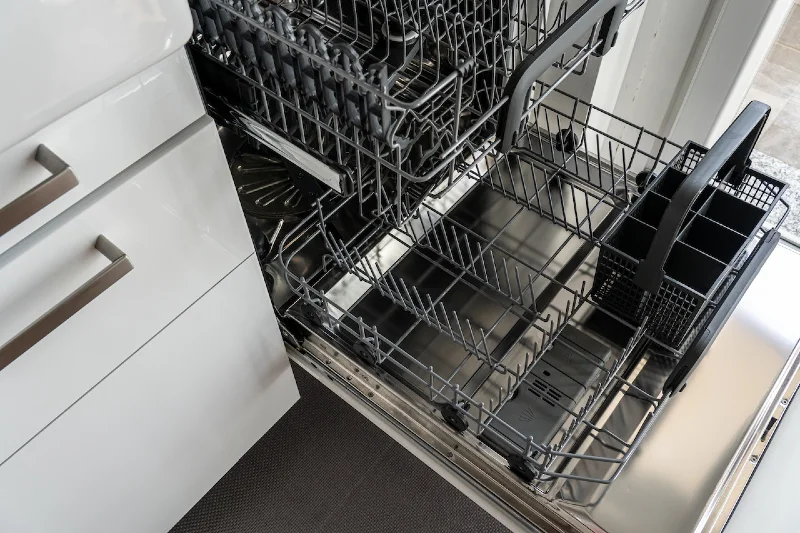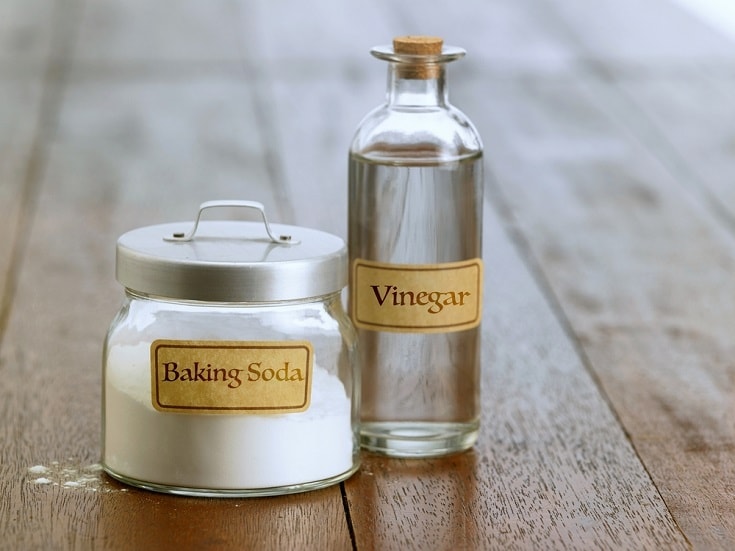Can You Put Drano in a Dishwasher? What You Need to Know!
-

- Last updated:

Drano is one of America’s most commonly utilized drain cleaners. It is mainly used in kitchen sink cleaning applications, especially when cleaning dirty drains and unblocking them if experiencing drainage issues. With Drano, you can easily break down food particles and grease on glasses and dishes. A major concern about using Drano is whether it can result in blocked drain issues. While this product can resolve draining issues in sinks, you should not use it with dishwashers at all.
Warning: Drano is made up of toxic chemicals that can permanently damage your dishwasher. It contains sodium hydroxide, which might not be acidic but can damage plastic surfaces. We understand that you might be tempted to use Drano for a clogged dishwasher, but you should not at all, especially if you want to increase the lifespan of your dishwasher.
In this article, we will discuss why using Drano is not a good idea while looking at alternative methods of unclogging a dishwasher. Read on to learn more.
Composition of Drano

In today’s market, there are several types of Drano products. They range from portable liquids to foaming gels. However, all Drano products have a similar chemical composition. The most prevalent ingredients include aluminum, bleach, and sodium peroxide.
Bleach is not a harmful cleaning product to have in a dishwasher. Besides, mixing bleach with water creates a compound that can clean and disinfect target appliances.
However, for you to come up with a viable cleaning solution, you have to mix equal parts. This means mixing 50% water and 50% bleach with a higher water proportion. The undiluted bleach is usually strong enough to remove paint off walls, so you will want to make sure you get the mixing proportions just right. Otherwise, you will end up destroying your dishwasher’s internal components.
Moreover, undiluted bleach produces chlorine gas, which is dangerous to people when inhaled. The acidic product produced can lead to lung damage from inhalation and cause severe burns when touched.
Even more alarming, some of the chemicals in Drano, like sodium hydroxide, can easily tear through any organic substance. Granted, it will help eliminate any congealed fat and grease in your drains, but it will be more destructive when combined with aluminum.
Can Drano Unclog a Dishwasher?
Usually, the drains in your kitchen are different from those in your dishwasher. Drano may be quite effective in unclogging drains in your toilet or kitchen, but it cannot remove debris from a dishwasher.
Dishwashers are equipped with several points, from where filters are installed to trap loose particles flowing through them. Drano may have negative effects on the filters even if it does not have any effect on the dishwasher. The chemicals present may not be enough to remove the dirt clusters from the dishwasher.
Eventually, you will reduce the efficiency of your dishwasher if you continuously use Drano to clean your kitchen utensils. If you notice that your dishwasher is clogged, add some vinegar when you are cleaning your dishes the next time. However, you may need to add some plain water cycle after the vinegar to avoid adding an acidic flavor to your meals.

Why Is Drano Not Suitable for Dishwashers?
Usually, Drano might be your first choice to unclog your dishwasher because it is readily available. However, despite popular belief, Drano is not made to unclog the plastic pipes mentioned above because its chemical composition features hydroxide peroxide. When the sodium peroxide mixes with moisture, it generates a significant amount of heat. At first, you might not experience any changes, but with time, the dishwasher will start generating severe heat.
The bubbles you notice when pouring Drano on the sink are similar to those produced when water boils. This may look beneficial (because it helps break down the grime into dissolvable particles that can pass through the drain and clean out your pipes), but it is not.
The extreme heat will also melt the plastic material used to make dishwasher pipes, thus causing permanent damage to them. This is the main reason why you should not use Drano on dishwashers. The inside of dishwashers is not only made from plastic but also unable to endure excessive chemical pressure.
Drano not only damages the drain pipes on the dishwasher, but it can also splash on your bowls and plates the next time you turn on your dishwasher. Ingesting sodium hydroxide can have repercussions on your health. People who have ingested sodium hydroxide tend to suffer from internal burns, among other symptoms, which can be permanent.
Furthermore, Drano can affect the whole dishwasher system, starting from the pipes to the pumps. If the chemicals from Drano affect a single element of the system, the whole machine cycle will be affected. Therefore, you will want to avoid sodium hydroxide in your meals at all costs.
Alternatives to Using Drano
Whenever a cleaning cycle from the dishwasher is running but no water coming from your machine, chances are that your machine is clogged. Nevertheless, since using Drano to unclog your machine may create more problems than it solves, do not fret. There are plenty of other alternatives that you can use to unclog a drain¹.
1. Remove the Dishes

Before you try any other suggestions, first remove the dishes previously put in the dishwasher. If the cleaning cycle had previously started, chances are that the dishes will have a soapy residue. Therefore, you might want to rinse out to prevent the soapy residue from being stuck on the dishes.
Then observe the filter bottom to confirm if there are any food residues stuck on the surface. If there are, clean them out. Return the lid to position and run the cleaning cycle without the dishes. If the drainage gets smooth, add the dirty dishes and use the dishwasher as required.
2. Disconnect Blocked Pipes and Remove Blockage Manually
Perhaps the most widely utilized way of getting rid of blockages in the dishwasher is disconnecting the pipes that you think have a blockage. Sometimes air gaps can cause blockages in your dishwasher’s drainage system. If it is present at the back of your sink, you can clear it manually.
Simply remove the cap, and poke around the inside of the pipe with a wire or any pointy item to break it down and remove any dust buildup. This process will help you break down any blocking substances manually. Repeat the process regularly as you run some water through the pipe to keep draining the loose particles from the pipe. Once the pipe passage is clear, cap the lid back on and run the dishwasher cycle to test the flow.
3. Use a Vinegar and Baking Soda Mixture

The other effective method is cleaning the dishwasher with a dash of vinegar and baking soda mixture. Simply pour equal parts of these ingredients into the dishwasher while ensuring the filters are removed before adding the mixture.
A mixture of these ingredients will react to produce a bubbling effect similar to that of using Drano. Just let the bubbles sit for a while before running down the surface with water to rinse and get a squeaky clean dishwashing machine.
4. Use the Garbage Disposal
If none of the above methods work, you can always opt to use a garbage disposal unit¹ if you have one. There should be extensions to the dishwasher. If your garbage disposal unit works, then cleaning it should solve drainage issues in your dishwasher as well. Just make sure that your dishwasher is running as you clean to drain the wastewater without obstruction.
How to Prevent Dishwashers From Clogging
Now that you are aware of the different methods of tackling clogs in your dishwasher, instead of using Drano solutions, how can one ensure that the same problem doesn’t arise a second time? The best way to avoid clogging issues in your dishwasher is by clearing any grease, food debris, and dirt buildup on your cutlery.
Simply clean your dishes before putting them into the dishwasher. Furthermore, dishwashers use the same cleaning cycle as other electrical kitchen appliances. Observe the equipment maintenance routine at least once every month to ensure that it works efficiently for a longer period.
Conclusion
Drano solutions are some of the best products for clearing out blocked drains in toilets, sinks, and baths. However, the chemical composition of Drano products makes them unsafe for use in dishwasher drains compared to those used in kitchen and toilet plumbing.
If you put Drano in your dishwasher, chances are high that the chemicals in the product can eat through your dishwasher’s internal components and the plumbing attached to the appliance. This can easily result in major damage and expensive repairs. Instead of using Drano, consider alternatives such as poking at the debris build-up or detaching the dishwasher pipe. You can also utilize DIY options like applying vinegar and baking soda.
Since a dishwasher is a delicate home appliance, using any hacks and tricks that prolong its durability is recommended. Just leave Drano Solutions for toilets and sinks.
Featured Image Credit: Leszek Glasner, Shutterstock
Contents



